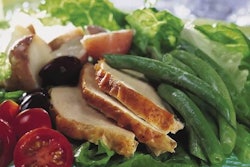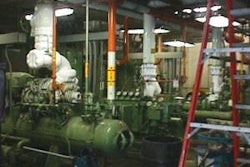.jpg?auto=format%2Ccompress&q=70&w=400)
Conservation of resources and preservation of the land have always been the hallmarks of a good farmer. Five of the USA's best poultry growers were recognized recently for their outstanding environmental stewardship by the U.S. Poultry & Egg Association. Each of these growers has combined raising poultry with other farming enterprises in ways that conserve resources and protect and improve their land.
McNeal Farm: Wood, the original biofuel
Ethanol production has sent corn prices soaring; it is enough to make biofuels a dirty word in the poultry industry. But with propane prices climbing ever higher, Missouri turkey grower Bill McNeal started looking for an alternative to propane for heating his turkey brooder house. McNeal raises toms for Cargill Value Added Meats in five houses on his Florence, Mo., farm. He knew that his gas bill was only going to get more expensive, unless he found an alternative fuel.
Bill and his wife Rita purchased their farm in 2000, but turkeys have been raised on the property for over 40 years. Brooding the 16,500 tom poults placed each flock in the one large brooder house consumes most of the farm's fuel. This house is curtain-sided and has 56 propane-fired brooder stoves. McNeal said that he investigated several renewable fuel options, including burning litter, corn and hay, but settled on a wood burning furnace. He chose wood because of its availability in his area and because commercial wood furnaces have a long history of use for home and commercial heating.
Three years ago, McNeal installed a Woodmaster 6500 wood furnace outside his brooder house to provide supplemental heat. The furnace produces up to 1 million British Thermal Units (BTUs) of heat, and its operation is regulated by the brooder house's electronic controller. There are four zones in the house, each with its own thermostat. When a zone's temperature drops 0.5 F below the set point, 170 F hot water is delivered to that zone's radiator. Each of the four radiators has a fan to move air over it and distribute heat in the house. The brooder stoves are still used to start the poults, but the stoves can gradually be turned off, a few at a time, as the birds grow older.
McNeal said that he gets most of his wood from landowners who have had their property logged and have no use for tops of the trees and other scrap wood. Typically, McNeal said that he pays around $5 for a pickup truck load of wood, which he cuts himself. He said that he burns 25 to 30 cords of wood per year. A cord of wood is four feet by four feet by eight feet. The furnace's fire box is five feet by four feet 10 inches, so McNeal said that he cuts his logs four feet long and that he generally doesn't split them.
The stove, radiators, piping and installation cost around $20,000. McNeal said that his annual fuel savings, less expense for getting the wood, has been around $11,000 per year.
McNeal's houses are curtain-sided and have metal trusses holding the roof up with high ceilings. Ceiling fans help to push hot air back down on the birds and aide with circulation of the heat from the radiators. To conserve heat in the brooder house in winter time, McNeal puts plastic on the outside of the north side curtain and puts bubble wrap and bat insulation inside of the curtain.
A wood furnace doesn't provide heat as "automatically" as a propane stove does. McNeal said that when the birds are three weeks of age or older, he might have to fill the firebox with wood two times a day, but when the birds are young and it is cold out, he will fill the firebox every three or four hours. So, the fire has to be tended to first thing in the morning and last thing every night, and the propane stoves are always there if the wood fire starts to burn out.
In addition to the turkeys, the McNeals raise cattle and grow hay. The McNeal Farm was chosen as the winner from the South Central Region.
Halterman Farm: Living, teaching stewardship
Arthur Halterman is planning to retire from his "day job" this year. For 30 years, he has taught middle school science and vocational education. Arthur and his wife JoEllen, who is also a teacher, operate a farm at their Baker, W.Va., home in their "spare time." They have two broiler-breeder houses on contract with Pilgrim's Pride and have 15,000 breeders on the farm each flock. In addition to the broiler breeders, the Halterman's have a cow-calf operation and produce hay on their 330 acre farm.
The Halterman's farm has steep slopes and lots of hillside acreage. Diversion ditches were built on the uphill side of the poultry houses and the litter shed to insure that no runoff goes into the buildings. The pastures are rotated so that grass height is maintained at three inches or more so that erosion and runoff are minimized. Streams and ponds are fenced off from the cattle.
Arthur takes every opportunity to develop curriculum which brings the environment into his classroom or he takes his students into the environment. His years of dedication have been recognized, Halterman was selected as the 2003 Primary Environmental Educator of the year for West Virginia. This award allowed Halterman to address each of the 14 Conservation Districts in the state of West Virginia. Halterman used this opportunity to share his unique experiences as a poultry farmer and educator.
The Arthur Halterman Farm was chosen as the winner from the Northeast Region.
Cub Run Poultry and Dairy Farm: Complimentary operations
Cub Run Poultry and Dairy Farm, McGaheysville, Va., is owned and operated by Gerald, Anita, Monte and Lavonne Heatwole. The family raises turkeys for the Virginia Poultry Growers Cooperative and has a 300-cow dairy operation. Corn, soybeans, rye and corn silage, which are used to feed the dairy cattle, are raised on the farm's acreage.
In 1989, one of the first nutrient management plans written in the state of Virginia was developed for and implemented by the Cub Run Poultry & Dairy Farm. Knowing the importance of nutrient management and its effect on the environment, Gerald Heatwole took a leadership role in implementing phosphorus based nutrient management plans and in 2000 the Heatwoles converted to a plan that applied poultry litter based on the application of phosphorus.
The Heatwoles finish 19,500 toms per flock in houses that were converted from two-stage to one-stage, tunnel-ventilated finisher houses. The poults are started at another farm and raised there until they are five weeks old. At five weeks of age, the birds are brought to the houses at Cub Run where they are held until they are 20 weeks old and weigh around 40 pounds.
Gerald Heatwole said, "God has richly blessed me and my family to live in one of the most beautiful places in the world. I must strive to be a good steward for the next generations to follow. When it is time for me to step aside, I want to leave our environment in a better state than when I started farming."
Cub Run Poultry & Dairy Farm was chosen as the winner from the Mid-Atlantic Region.
Paul Wallace: Outstanding Young Farmer
Paul Wallace took over his uncle's broiler and cattle farm and has continued the improvements on the land started by his uncle. The J. Paul Wallace Farm, Yatesville, Ga., has 425 acres and eight broiler houses. Wallace raises 216,000 birds per flock for Perdue Farms.
The farm has three ponds and two streams, and working with NRCS, Wallace has developed and implemented a conservation plan. All the ponds and streams have been fenced off to keep the cattle out. A riparian buffer has been maintained between the fences and water areas. The buffer zones consist of grass and trees that were planted to help filter out any sediment in runoff. Around half of the poultry complex's storm water drainage is filtered through a sediment pond, and the other half of the storm water is passed over an extensive grass waterway system. Gravel has been placed around the cattle waterers and all low lying wetland areas are fenced off to cattle.
In 2005, J. Paul Wallace was the recipient of the Outstanding Young Farmer Award for the state of Georgia and placed in the top 10 in the nation. Wallace credits his knowledge of agriculture from lessons learned from his uncle, especially the importance of conservation and giving back to the community. Wallace said, "We as an industry need to be more proactive and not reactive to environmental issues. We are looking for cutting-edge technology to continue operating our farm in a sustainable method while protecting the environment."
The J. Paul Wallace Farm was chosen as the winner from the Southeast Region.
Smotherman Turkey Farm: Career change pays off
Ken Smotherman, Jr., and his wife Dana were living and working in Phoenix, Ariz., when they took an extended vacation in Texas to visit friends who owned a turkey farm. Smotherman said about that trip, "After that experience, I thought that turkey farming might be something that I, as well as my family, would really enjoy doing." Smotherman was working in information mManagement and his wife was a registered nurse, so what he was contemplating was a big step. "I would have to admit that when we purchased these farms I had virtually no idea what agriculture' really was." Six years later, the Smotherman's farm was selected as the winner from the Southwest Region.
Smotherman Farms raises turkeys for Cargill Value Added Meats in West, Texas, on a combination of owned and leased farms. The family purchased a company-owned farm from Cargill and is leasing another farm from Cargill. Ken oversees general operation and manages the finishing houses and Dana manages all of the brooder houses with help from daughters, Kasey and Whitney. In total, the farms brood 63,000 hens per flock and finish around 125,000 per flock. In addition to the turkeys, the family raises cattle, goats, horses and hay on over 600 acres.
The Smotherman's are extremely happy with the decision that they made six year ago to become turkey growers. "Both my wife and I regularly tell each other, and anyone else within earshot that this was the best decision that we have ever made. We really enjoy every single day."


















